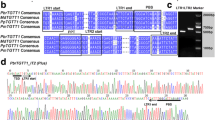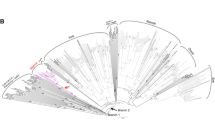Abstract
LTR retrotransposons (LTR-RTNs) are widespread constituents of eukaryote genomes, particularly plant genomes. Although LTR-RTNs from plants were thought to be transcriptionally silent in somatic tissues, evidences of activity under certain conditions are available for some of them. In order to investigate LTR-RTNs in the Citrus sinensis genome, we analysed them by PCR using degenerate primers corresponding to highly conserved domains. All elements of the two types of LTR-RTN comprise about 23% of the genome, the copia group contribution being higher (13%) than the gypsy one (10%). From dendogram analysis, we report seven new copia RTN families, named CIRE1 to CIRE7. Here, we report on the first complete retrotransposon identified in Citrus (named CIRE1), which has all the features of a typical copia RTN. CIRE1 retrotransposon has around 2,200 full-length copies, contributing to 2.9% of the C. sinensis genome. CIRE1 has a root-specific expression in sweet orange plants. We have also determined that wounding and exogenous application of plant hormones, as methyl jasmonate and auxin, increase the transcription level of CIRE1 in leaf tissues. In addition, we show that CIRE1 5′LTR promoter can drive transient expression of the gus reporter gene in heterologous plant systems. These findings confirm CIRE1 as one of the few transcriptionally active RTNs described in plants and to our knowledge the first one to be reported in Citrus species.





Similar content being viewed by others
Abbreviations
- EST:
-
Expressed sequence tag
- GUS:
-
β-glucuronidase
- LTR:
-
Long terminal repeat
- MeJA:
-
Methyl jasmonate
- NAA:
-
Naphthaleneacetic acid
- ON:
-
Overnight
- ORF:
-
Open reading frame
- PCR:
-
Polymerase chain reaction
- RT:
-
Reverse transcriptase
- RTN:
-
Retrotransposon
- TE:
-
Transposable element
References
Aledo R, Raz R, Monfort A, Vicient CM, Puigdomènech P, Martínez-Izquierdo JA (1995) Chromosome localization and characterization of a family of long interspersed repetitive DNA elements from the genus Zea. Theor Appl Genet 90:1094–1100
Altschul SF, Gish W, Miller W, Myers EW, Lipman DJ (1990) Basic local alignment search tool. J Mol Biol 215:403
Arabidopsis Genome Initiative (2000) Analysis of the genome sequence of the florewing plant Arabidopsis thaliana. Nature 408:796–815
Araujo PG, Casacuberta JM, Costa APP, Hashimoto RY, Grandbastien MA, Van Sluys MA (2001) Retrolyc1 subfamilies defined by different U3 LTR regulatory regions in the Lycopersicon genus. Mol Genet Genomics 266:35–41
Arumuganathan K, Earle ED (1991) Nuclear DNA Content of Some Important Plant Species. Plant Mol Biol Rep 9:211–215
Asíns M, Monforte A, Mestre P, Carbonell E (1999) Citrus and Prunus copia-like retrotransposons. Theor Appl Genet 99:503–510
Beguiristain T, Grandbastien MA, Puigdomenech P, Casacuberta JM (2001) Three Tnt1 subfamilies show different stress-associated patterns of expression in tobacco. Consequences for retrotransposon control and evolution in plants. Plant Physiol 127:212–221
Bernet GP, Asins MJ (2003) Identification and genomic distribution of gypsy like retrotransposons in Citrus and Poncirus. Theor Appl Genet 108(1):121–130
Bradford M (1976) A rapid and sensitive method for the quantification of microgram quantities of protein utilizing the principle of protein dye binding. Anal Biochem 72:248–254
Bretó MO, Ruiz C, Pina JA, Asins MJ (2001) The diversification of Citrus clementina Hort. Ex Tan., a vegetatively propagated crop species. Mol Phylogenet Evol 21:285–293
Casacuberta JM, Vernhettes S, Audeon C, Grandbastien MA (1997) Quasispecies in retrotransposons: a role for sequence variability in Tnt1 evolution. Genetica 100:109–117
Costa AP, Scortecci KC, Hashimoto RY, Araujo PG, Grandbastien MA, Van Sluys MA (1999) Retrolyc1–1, a member of the Tntl retrotransposon super-family in the Lycopersicon peruvianum genome. Genetica 107:65–72
Farman ML, Tosa Y, Nitta N, Leong SA (1996) MAGGY, a retrotransposon in the genome of the rice blast fungus Magnaporthe grisea. Mol Gen Genet 251(6):665–674
Farmer EE, Ryan CA (1992) Octadecanoid precursors of jasmonic acid activate the synthesis of wound-inducible proteinase inhibitors. Plant Cell 4:129–134
Feng DF, Doolittle RF (1987) Progressive sequence alignment as a prerequisite to correct phylogenetic trees. J Mol Evol 25:351–360
Flavell AJ, Smith DB, Kumar A (1992) Extreme heterogeneity of Ty1-copia group retrotransposons in plants. Mol Gen Genet 231:233–242
García-Martínez J, Martínez-Izquierdo JA (2003) Study on the evolution of the Grande retrotransposon in the Zea genus. Mol Biol Evol 20:831–841
Grandbastien MA (1998) Activation of plant retrotransposons under stress conditions. Trends Plant Sci 3(5):181–187
Grandbastien MA, Spielmann A, Caboche M (1989) Tnt1, a mobile retroviral-like transposable element of tobacco isolated by plant cell genetics. Nature 337:376–380
Grandbastien M, Audeon C, Bonnivard E, Casacuberta JM, Chalhoub B, Costa APP, Le QH, Melayah D, Petit M, Poncet C, Tam SM, Van Sluys MA, Mhiri C (2005) Stress activation and genomic impact of Tnt1 retrotransposons in Solanaceae. Cytogenet Genome Res 110:229–241
Gribbon BM, Pearce SR, Kalendar R, Schulman AH, Paulin L, Jack P, Kumar A, Flavell AJ (1999) Phylogeny and transpositional activity of Ty1-copia group retrotransposons in cereal genomes. Mol Gen Genet 261:883–891
Himanen K, Boucheron E, Vanneste S, de Almeida Engler J, Inze D, Beeckman T (2002) Auxin-mediated cell cycle activation during early lateral root initiation. Plant Cell 14:2339–2351
Hirochika H (1993) Activation of tobacco retrotransposons during tissue culture. EMBO J. 12(6):2521–2528
Hirochika H, Otsuki H, Yoshikawa M, Otsuki Y, Sugimoto K, Takeda S (1996a) Autonomous transposition of the tobacco retrotransposon Tto1 in rice. Plant Cell 8:725–734
Hirochika H, Sugimoto K, Otsuki Y, Tsugawa H, Kanda M (1996b) Retrotransposons of rice involved in mutations induced by tissue culture. Proc Natl Acad Sci USA 93:7783–7788
Jefferson RA, Kavanagh TA, Bevan MW (1987) GUS fusions: β-glucuronidase as a sensitive and versatile gene fusion marker in higher plants. EMBO J 6:3901–3907
Kentner EK, Arnold ML, Wessler SR (2003) Characterization of high-copy-number retrotransposons from the large genomes of the Lousiana Iris species and their use as molecular markers. Genetics 164:685–697
Kimura Y, Tosa Y, Shimada S, Sogo S, Kusaba M, Sunaga T, Betsuyaku S, Eto Y, Nakayashiki H, Mayama S (2001) OARE-1, a Ty1-copia retrotransposon in oat activated by abiotic and biotic stresses. Plant Cell Physiol 42(12):1345–1354
Konieczny A, Voytas DF, Cummings MP, Ausubel FM (1991) A superfamily of Arabidopsis thaliana retrotransposons. Genetics 127(4):801–809
Kumar A, Bennetzen JL (1999) Plant Retrotransposons. Annu Rev Genet 33:479–532
Kumar S, Tamura K, Jakobsen IB, Nei M (2001) MEGA2.1: molecular evolutionary genetics analysis software, Bioinformatics 17:1244–1245
Manninen I, Schulman AH (1993) BARE-1, a copia-like retroelement in barley (Hordeum vulgare L.). Plant Mol Biol 22:829–846
Marillonnet S, Wessler SR (1998) Extreme structural heterogeneity among the members of a maize retrotransposon family. Genetics 150:1245–1256
Marlor RL, Parkhurst SM, Corces VG (1986) The Drosophila melanogaster gypsy transposable elements encodes putative gene products homologous to retroviral proteins. Mol Cell Biol 6:1129–1134
Melayah D, Bonnivard E, Chalhoub B, Audeon C, Grandbastien MA (2001) The mobility of the tobacco Tnt1 retrotransposon correlates with its transcriptional activation by fungal factors. Plant J 28(2):159–168
Menossi M, Puigdomènech P, Martínez-Izquierdo JA (2000) Improved analysis of promoter activity in biolistically transformed plant cells. BioTechniques 28:54–58
Mount SM, Rubin GM (1985) Complete nucleotide sequence of the Drosophila transposable element copia: homology between copia and retroviral proteins. Mol Cell Biol 5:1630–1638
Okamoto H, Hirochika H (2000) Efficient insertion mutagenesis of Arabidopsis by tissue culture-induced activation of the tobacco retrotransposon Tto1. Plant J 23(2):291–304
Ollitrault P, Dambier D, Luro F, Duperray C (1995) Nuclear genome size variations in Citrus. Fruits 49:390–393
Pearce SR, Harrison G, Li D, Heslop-Harrison J, Kumar A, Flavell AJ (1996) The Ty1-copia group retrotransposons in Vicia species: copy number, sequence heterogeneity and chromosomal localisation. Mol Gen Genet 250:305–315
Pelissier T, Tutois S, Deragon J, Tourmente S, Genestier S, Picard G (1995) Athila, a new retroelement from Arabidopsis thaliana. Plant Mol Biol 29:441–452
Pouteau S, Huttner E, Grandbastien MA, Caboche M (1991) Specific expression of the tobacco Tnt1 retrotransposon in protoplasts. EMBO J 10:1911–1918
Pouteau S, Grandbastien MA, Boccara M (1994) Microbial elicitors of plant defense responses activate transcription of a retrotransposon. Plant J 5(4):535–542
Rozas J, Rozas R (1999) DnaSP version 3.14: an integrated program for molecular population genetics and molecular evolution analysis. Bioinformatics 15:174–175
Saitou N, Nei M (1987) The Neighbor-Joining method: a new method for reconstructing phylogenetic trees. Mol Biol Evol 4:406–425
SanMiguel P, Tikhonov A, Jin YK, Motchoulskaia N, Zakharov D, Melake-Berhan D, Bennetzen JL (1996) Nested retrotransposons in the intergenic regions of maize genome. Science 274:765–768
Sasaki T et al (2002) Genome sequence and structure of rice chromosome 1. Nature 420:312–316
Smyth DR, Kalitsis P, Joseph JL, Sentry JW (1989) Plant retrotransposon from Lilium henryi is related to Ty3 of yeast and the gypsy group of Drosophila. Proc Natl Acad Sci USA 86:5015–5019
Suoniemi A, Narvanto A, Schulman AH (1996) The BARE1 retrotransposon s transcribed in barley from a LTR promoter active in transient assays. Plant Mol Biol 31:365–376
Suoniemi A, Tanskanen J, Schulman AH (1998) Gypsy-like retrotransposons are widespread in the plant kingdom. Plant J 13:699–705
Takeda S, Sugimoto K, Otsuki H, Hirochika H (1998). Transcriptional activation of the tobacco retrotransposn Tto1 by wounding and methyl jasmonate. Plant Mol Biol 36:365–376
Takeda S, Sugimoto K, Otsuki H, Hirochika H (1999) A 13-bp cis-regulatory element in the LTR promoter of the tobacco retrotransposon Tto1 is involved in responsiveness to tissue culture, wounding, methyl jasmonate and fungal elicitors. Plant J 18(4):383–393
Tapia G, Verdugo I, Yánez M, Ahumada I, Theoduloz C, Cordero C, Poblete F, González E, Ruiz-Lara S (2005) Involvement of ethylene in stress-induced expression of the TLC1–1 retrotransposon from Lycopersicum chilense Dun. Plant Physiol 138:2075–2086
Thompson JD, Higgins DG, Gibson TJ (1994) Clustal W: improving the sensitivity of progressive multiple sequence alignment through sequence weighting, position specific gap penalties and weight matrix choice. Nucleic Acids Res 22:4673–4680
Turcich MP, Bokhari-Riza A, Hamilton DA, He C, Messier W, Stewart CB, Mascarenhas JP (1996) PREM-2, a copia-type retroelement in maize is expressed preferentially in early microspores. Sex Plant Reprod 9:65–74
Vershinin AV, Ellis TH (1999) Heterogeneity of the internal structure of PDR1, a family of Ty1/copia-like retrotransposons in pea. Mol Gen Genet 262:703–713
Vicient CM (1995) Caracterización molecular de Grande1, un nuevo tipo de retrotransposón del género Zea. PhD Thesis, University of Barcelona, Spain
Vicient CM, Schulman AH (2002) Copia-like retrotransposons in the rice genome: few and assorted. Genome Lett 1:35–47
Vicient CM, Suoniemi A, Anamthawat-Jónsson K, Tanskanen J, Beharav A, Nevo E, Schulman AH (1999) Retrotransposon BARE-1 and its role in genome evolution in the genus Hordeum. Plant Cell 11:1769–1784
Vicient CM, Jääskeläinen MJ, Kalendar R, Schulman AH (2001) Active retrotransposons are a common feature of grass genomes. Plant Physiol 125:1283–1292
Voytas DF, Cummings MP, Koniczny A, Ausubel FM, Rodermel SR (1992) Copia-like retrotransposons are ubiquitous among plants. Proc Natl Acad Sci USA 89:7124–7128
Waugh R, McLean K, Flavell AJ, Pearce SR, Kumar A, Thomas BB, Powell W (1997) Genetic distribution of BARE-1-like retrotransposable elements in the barley genome revealed by sequence-specific amplification polymorphisms (S-SAP). Mol Gen Genet 253:687–694
Wessler SR, Bureau TE, White SE (1995) LTR-retrotransposons and MITE: important players in the evolution of plant genomes. Curr Opin Genet Dev 5:814–821
Yanez M, Verdugo I, Rodríguez M, Prats S, Ruiz-Lara S (1998) Highly heterogeneous families of Ty1/copia retrotransposons in the Lycopersicum chilense genome. Gene 222:223–228
Acknowledgments
The authors are indebted to Dr. Carlos Vicient and Dr. JM Casacuberta for critical reading of the manuscript. LRC was recipient of a predoctoral fellowships from Autonomous Catalan Government (Generalitat) (2001FI 00143). Some funds for this study were provided by CERBA (Generalitat of Catalonia). This work was mainly supported by the grant BIO99-1175 (CICYT) from the MEC of Spanish Govern to JAMI.
Author information
Authors and Affiliations
Corresponding author
Additional information
Communicated by M.-A. Grandbastien.
Nucleotide sequence data reported are available in the EMBL database under the accession numbers AM117724 to AM117738, AM236246 to AM236248 (sweet orange copia-like rt sequences; CoSi1 to CoSi19) and AM040263 (CIRE1 retrotransposon).
Rights and permissions
About this article
Cite this article
Rico-Cabanas, L., Martínez-Izquierdo, J.A. CIRE1, a novel transcriptionally active Ty1-copia retrotransposon from Citrus sinensis . Mol Genet Genomics 277, 365–377 (2007). https://doi.org/10.1007/s00438-006-0200-2
Received:
Accepted:
Published:
Issue Date:
DOI: https://doi.org/10.1007/s00438-006-0200-2




